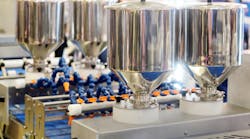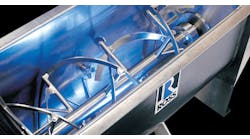Mixing and blending may be a simple, basic processing step, but it can also benefit from a little sophistication.
Digital technology has opened up new possibilities for efficiency and consistency in mixing and blending operations. In terms of both how the equipment handles a batch and how it interacts with the rest of the line, the right level of electronic monitoring and control can greatly improve the process.
“Digital technology for mixing and blending equipment has advanced a great deal over the past few years as the price of increasingly intelligent technology has fallen,” says Jonathan Reed, global head of automation, electrical and digital for SPX Flow.
As with most batch or semi-batch operations, digital enhancement falls into two basic categories: improvement to the process itself, and improved integration with upstream and downstream processes. The former includes the basic capacity to store and/or execute recipes, altering the mixing parameters as needed to accommodate things like changes in ingredients.
PLCs and other controls can help coordinate actions both within and outside a mixer. Photo: SPX Flow
“For example, a drink containing artificial sweetener is much more difficult to mix than one containing sugar,” Reed says. “The mixer control system will ensure mixing is optimized. It will receive a signal to produce a certain recipe and volume and will communicate with other PLCs and automation systems to obtain the required ingredients and confirm batch details to destination processes.”
Machines from Ross Mixers are available with sequence-driven recipe controls, says Gary Barber, general manager of the Ross Systems & Controls unit. These can store 10 recipes with variations of agitator speed, batch time, product temperature and vacuum levels. Recipes are accessible through a matrix grid on a color touchscreen.
In the case of custom-built mixers, digital technology can help before the first piece of metal is bent. Reed says that integrating automation with computational fluid dynamics enables SPX to build an accurate digital simulation that will guide the custom design of a mixer. “Having this capability removes the need for ‘cushions’ in parameters and enables further optimization of mixing times,” he adds.
This kind of precision leads to long-term performance improvement, Reed says. “Knowing the exact mix time to achieve the results desired increases productivity, reduces running costs and gives complete peace of mind with scientific evidence to ensure the mixing process is performing properly. Removing buffers in mixing times and parameters additionally removes the need to push the equipment so hard, thereby offering the potential for increased lifetime and reliability.”
Adding ingredients
One of the most significant potential digital improvements to mixing and blending comes in ingredient metering. Having ingredients added during mixing, as opposed to further upstream, allows mixing to be moved as far to the end of the processing line as possible. This in turn minimizes the amount of piping and other equipment that needs to be cleaned between product changes – an especially vital consideration for any product that uses allergens like tree nuts.
Digital technology allows the Infini-Mixer from Axiflow to run on a truly continuous basis.
Digital metering is one of the things that makes equipment from Axiflow Technologies able to do what Joby Ferary, manager for North American sales, calls “true continuous mixing.” Axiflow’s Infini-Mix can deliver a consistent flow of blended product to packaging lines or any other downstream point.
Infini-Mix works by slaving the addition of ingredients, like almonds, to the flow of the main liquid ingredient, like chocolate. A mass flowmeter measures the inflow of the main ingredient, and a control loop passes through a PLC and the controller of a solids feeder like an auger filler. The auger will rotate as needed to push out enough solids to match the amount of the main ingredient.
This kind of coordination lets the mixer run without stopping to wait for the next batch of ingredients, Ferary says. “When you do a truly continuous single-pass system, you run until your ingredients are out.” In addition, having the mixer at or near the end of the line makes for easier cleaning.
Ferary uses the example of a chocolate maker switching from almonds to crisped rice: “All you’ve got to do now is clean the mixer, and now you start dosing in the crispies. So you don’t have to clean the entire process, especially when you have allergens like nuts – think about all the piping you’d have to clean before you can go on to the next product.”
Digital monitoring can help guide the mixing process by giving feedback on process parameters like viscosity and temperature, for either manual or automatic correction. “Implementing devices like viscosity metering and/or motor load monitoring in kilowatts are good indicators of batch consistency,” Barber says. “We can also graph any variable in real time to see the mixing process in action.”
For instance, high-shear mixing often imparts heat; if product is getting too hot, it would be a sign to either slow down the blades or increase the flow of coolant to a jacketed vessel. This is most often done manually but could be accomplished automatically with a feedback loop, Barber says. Most end users opt for the former because of price.
Up and down the line
Besides helping with the actual process, digital controls can help mixers and blenders interface and coordinate with processes on either side of the line. These setups can be as simple as an on/off contact switch that signals that the next batch is ready, or as sophisticated as the end user wants – and can pay for.
In more advanced setups, equipment, instruments and other devices throughout the plant are on what amounts to an intranet. They are all networked on a standard communication protocol like EtherNet/IP or Modbus, enabling them to share data. To access this network, each device has one or more IP addresses, similar to the ones computers and other devices use to access the internet.
A Ross mixer might have multiple addresses. For example, one model has three components, each with its own motor: an anchor with three blades on it that sweeps around the vessel’s inside walls, a high-speed disperser and a high-speed emulsifier. The drives that feed current to those motors would each have their own IP addresses. If they were networked, they could receive signals through the equipment’s PLC telling them when and how fast to run the motors, and could send data about process parameters and other conditions. (An alternative, simpler arrangement would be connection to a PLC with two Ethernet ports. One interfaces with other equipment while the other allows the PLC to manage the mixer’s drives, operator interface and other digital components.)
A new vista of connectivity comes with the Internet of Things (IoT). Hooking up mixers and blenders to the internet allows for easy comparison of operational data among equipment, which can suggest long-term operational improvements.
“By connecting to the Internet of Things, running data of numerous mixers can be cross-referenced,” Reed says. “This comparative data will show how well a mixer is running and help determine why that is, revealing ways to improve slower machines and further increase optimization of overall plant productivity.”
Digital technology can bring new levels of sophistication to the seemingly routine operation of mixing and blending. Virtually the only limit is the end user’s imagination – and budget.
As Barber puts it: “Our biggest challenge is matching controls to meet our customer's needs as well as their budgets.”


